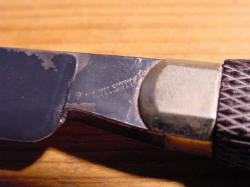Altered Surgical Instruments and Restoration
When you deal with instruments that are over 100 years old, you have to expect to find some rust or discoloration. In most cases, it is best to not clean or restore the instrument and leave them as history has presented them. Restoration of metal can do more harm than good. See restoration of wood surgical cases for additional information. There are well meaning individuals who do clean instruments and in the process, destroy them. In general, unless you are extremely well versed in restoration of antiques, the best policy is to do nothing to alter the metal. A general oiling or cleaning is acceptable, but only for dirt, grim, or grease. Removing age related patina is a major cause for damage and resulting decreased value. The following set of photos illustrate the level of damage which someone can do in a machine shop with a grinding wheel or sander. The maker name 'Tiemann' has been completely obliterated on the shank of the blade of this amputation knife. By comparison, see the photo on the right in which the metal is untouched and the full name remains as it came out of the factory. My guess would be that someone was trying to hide the name so as to 'plant' the knife in a set which was not consistent with the Tiemann's name. Dishonest at the least.
|

